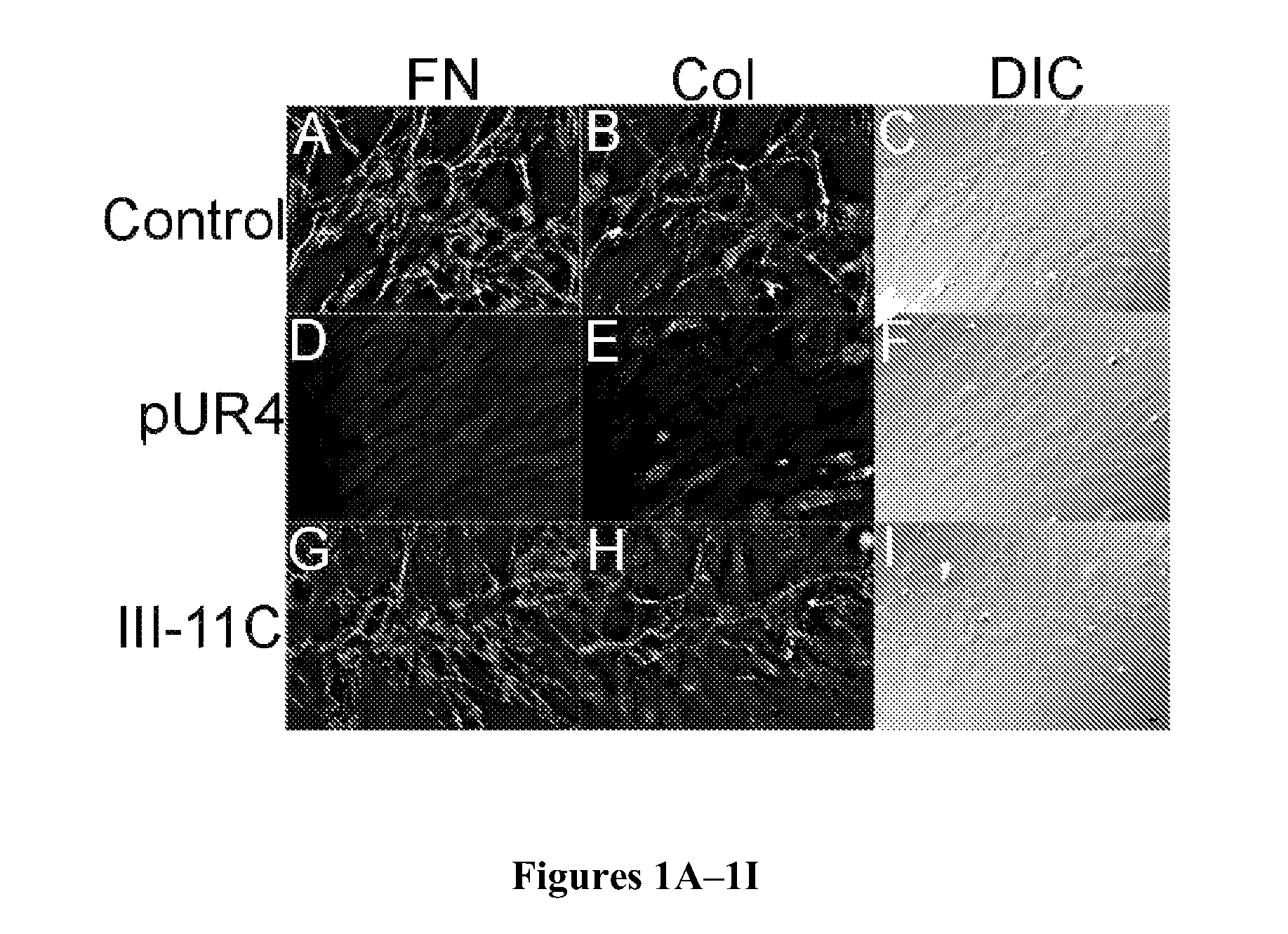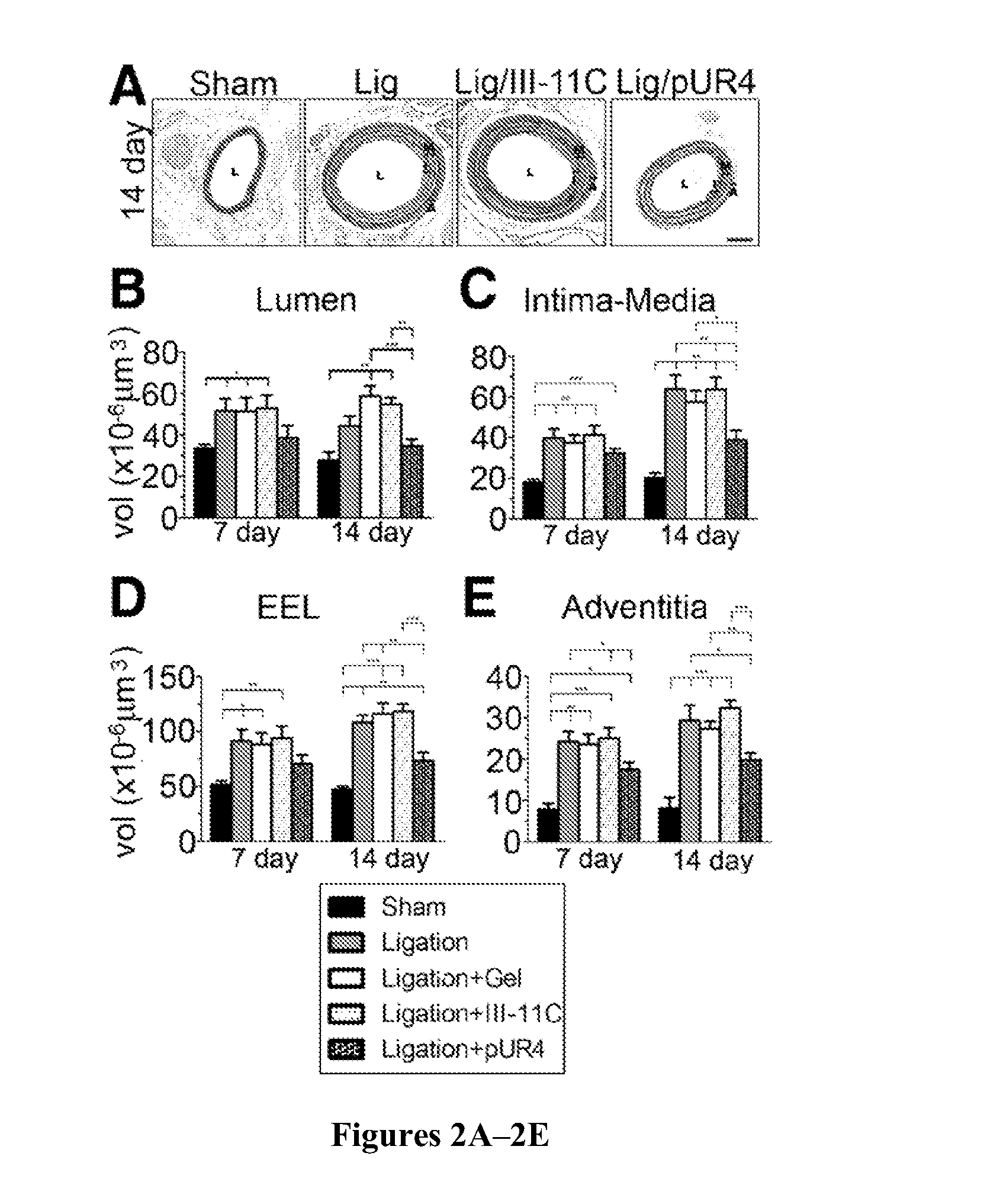Treatment of fibrosis-related disorders using fibronectin binding proteins and polypeptides
a technology of fibronectin and binding proteins, applied in the direction of peptide/protein ingredients, peptide sources, drug compositions, etc., can solve the problems of fibroblast proliferation, aberrant ecm remodeling, and inability to achieve therapeutic utility, so as to prevent fibrosis, improve heart function, and prevent fibrosis
- Summary
- Abstract
- Description
- Claims
- Application Information
AI Technical Summary
Benefits of technology
Problems solved by technology
Method used
Image
Examples
example 1
Peptide pUR4 Blocks In Vitro Fibronectin and Collagen Deposition in SMCs
[0127]The ability of pUR4 to inhibit SMCs deposition of fibronectin and collage was investigated. pUR4 has been shown to inhibit fibronectin polymerization in vitro in fibroblasts, osteosarcoma cells, and endothelial cells, but it was not known whether this peptide would have any effect on SMCs (Zhou et al., “Fibronectin Fibrillogenesis Regulates Three-Dimensional Neovessel Formation,”Genes Dev. 22:1231-1243 (2008); Tomasini-Johansson et al., “Peptide from Adhesin F1 Inhibits Fibronectin Matrix Assembly,”J. Biol. Chem. 276:23430-23439 (2001), which are hereby incorporated by reference in their entirety). As shown in FIG. 1D, when compared to 1A, addition of pUR4 to cultured SMCs inhibited the deposition of endogenous fibronectin into the ECM. Previous data has shown that fibronectin regulates the deposition of other proteins into the ECM, including type I collagen (Sottile et al., “Fibronectin Polymerization Reg...
example 2
Peptide pUR4 Blocks Vascular Remodeling
[0130]Fibronectin is known to affect SMC growth, migration, and differentiation in vitro (Mercurius et al., “Inhibition of Vascular Smooth Muscle Cell Growth by Inhibition of Fibronectin Matrix Assembly,”Circulation Research 82:548-556 (1998); DiMilla et al., “Maximal Migration of Human Smooth Muscle Cells on Fibronectin and Type IV Collagen Occurs at an Intermediate Attachment Strength,”J. Cell. Biol. 122:729-737 (1993); String a et al., “Role of Newly Synthesized Fibronectin in Vascular Smooth Muscle Cell Migration on Matrix-Metalloproteinase-Degraded Collagen,”Biochem. Soc. Trans. 30:102-111 (2002); Hedin et al., “Diverse Effects of Fibronectin and Laminin on Phenotypic Properties of Cultured Arterial Smooth Muscle Cells,”J. Cell. Biol. 107:307-319 (1988), which are hereby incorporated by reference in their entirety). Hence, fibronectin could promote vascular remodeling by multiple mechanisms. To determine whether peptide pUR4 blocks intima-...
example 3
Peptide pUR4 Decreases ECM Accumulation
[0132]Immunohistochemistry (IHC) was used to determine whether pUR4 caused a reduction in fibronectin and collagen I deposition in the left carotid artery. IHC analysis indicates that there was a dramatic reduction in the accumulation of collagen I and fibronectin in the media and adventitia 7 and 14 days after surgery in pUR4 treated animals in comparison with control animals (FIG. 3A). At 7 days after surgery, pUR4 totally prevented increased fibronectin deposition (FIGS. 3B and 3C). At 14 days after surgery, fibronectin and collagen levels were still decreased in pUR4-treated animals in comparison to control peptide-treated animals. The decrease in collagen deposition parallels the decrease in fibronectin deposition (FIGS. 3D and 3E).
PUM
| Property | Measurement | Unit |
|---|---|---|
| length | aaaaa | aaaaa |
| length | aaaaa | aaaaa |
| thickness | aaaaa | aaaaa |
Abstract
Description
Claims
Application Information
 Login to View More
Login to View More - R&D
- Intellectual Property
- Life Sciences
- Materials
- Tech Scout
- Unparalleled Data Quality
- Higher Quality Content
- 60% Fewer Hallucinations
Browse by: Latest US Patents, China's latest patents, Technical Efficacy Thesaurus, Application Domain, Technology Topic, Popular Technical Reports.
© 2025 PatSnap. All rights reserved.Legal|Privacy policy|Modern Slavery Act Transparency Statement|Sitemap|About US| Contact US: help@patsnap.com



